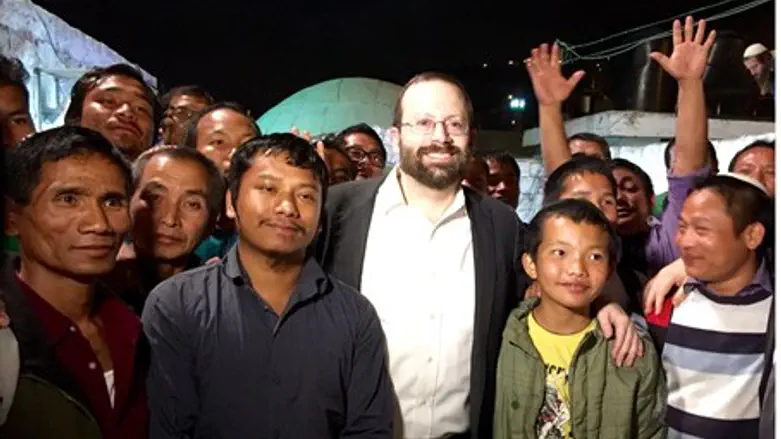
Pilgrims to Joseph's Tomb in the Biblical city of Shechem on Monday night were treated to moving scenes, as members of a lost Tribe of Israel reunited with their ancient forefather for the first time in well over two millennia.
The Bnei Menashe (literally “Children of Manasseh”), claim descent from the Israelite tribe of Menashe, one of the 10 Lost Tribes of Israel exiled by the Assyrian Empire some 2,700 years ago.
Today, some 3,000 Bnei Menashe live in Israel, mainly in Judea, Samaria and the Galilee. The remaining 7,000 Bnei Menashe reside in India – primarily in the northeastern states of Mizoram and Manipur, which border Burma.
The group which is aiding the aliyah of the Bnei Menashe - Shavei Israel, founded and headed by Rabbi Michael Freund - arranged for Monday's unique visit as both a part of the tribe's homecoming, as well as to pray for the remaining Bnei Menashe who are still awaiting permission to move to Israel.
Rabbi Freund described the experience as a "family reunion of sorts."
"For the first time in 2,700 years, a group of 100 recent Bnei Menashe immigrants from India visited Joseph's Tomb in Shechem (Nablus)," he told Arutz Sheva.
"What makes this so unique is that the Bnei Menashe are descendants of the Tribe of Manasseh, who was the Biblical Joseph's eldest son. Hence it was akin to a family reunion of sorts.
"In addition, according to tradition, Joseph's sons Manasseh and Ephraim are buried alongside him, adding to the sense that it was the closing of an historical circle."
Freund coordinated the visit to PA-controlled Shechem with the IDF.
"While there, the Bnei Menashe prayed and wept at the tomb, and appealed to G-d to bring the remaining 7,000 Bnei Menashe still in India on Aliyah," he recounted.
"For me, it was a very moving sight to see the Bnei Menashe, descendants of Manasseh and Joseph, standing at the tomb of their ancestors after being cut off from our people for so many centuries. If that’s not a miracle, what is?"
While at the Tomb, ecstatic pilgrims sang their community's de-facto anthem: a song in their native Kuki language describing their yearning to return to Zion.
According to the Bnei Menashe’s oral tradition, their ancestors arrived in northeastern India after centuries of wandering from slavery in Assyria, through Persia, Afghanistan, Hindu-Kush, Tibet and as far as the Chinese city of Kaifeng, where they were once again forced to escape slavery.
Finally, after a near-eternity of slavery, persecution and forced assimilation, at least some of them traveled on to Burma (Myanmar) and India, where they finally settled, cut off from their fellow Israelites and just barely clinging to their ancestor’s heritage via a number of ancient traditions, including the legend of their ancestor “Manmaseh” and a number of recognizable Jewish practices and songs.
250 more Bnei Menashe are slated to arrive in Israel later this month, as part of Israel's commitment to bring the entire community home to Israel.
Shavei Israel hopes to complete the aliyah of the Bnei Menashe by 2020.